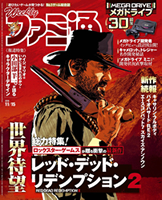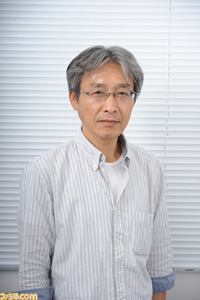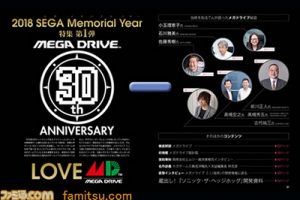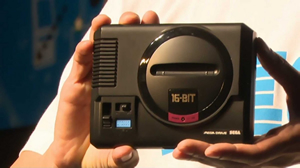 This interview first appeared in the November 2018 issue Famitsu magazine as part of a celebration of the Mega Drive’s 30th anniversary. In it, Sega product designer Masami Ishikawa shared his thoughts on what it was like developing Sega’s most successful piece of consumer hardware.
This interview first appeared in the November 2018 issue Famitsu magazine as part of a celebration of the Mega Drive’s 30th anniversary. In it, Sega product designer Masami Ishikawa shared his thoughts on what it was like developing Sega’s most successful piece of consumer hardware.
Ishikawa joined Sega in 1979 to work on coin-op machines but soon found himself working with home consoles. He became head of Sega’s home console R&D work in the 1980s, leading teams on the SG-1000 II and the Mark III/Master System before taking on his most ambitious project, the Mega Drive.
* * *
Famitsu: Ishikawa-san, you were given the task of designing the Mega Drive. Speaking frankly, how did you feel about it at the time?
 Masami Ishikawa: To be honest, I didn’t think I’d be able to do it (laughs). Sato-san told me “there are new components available, don’t you want to try them out?” and handed me the task of developing the Mega Drive. It’s made up of two CPUs, a main and a sub, and dual VRAM. I was asked to get as close to possible to the System 16 arcade board in terms of graphics, so I had to use these elements as well as possible to create a high-level home console. Figuring out how to do that caused me a lot of anguish.
Masami Ishikawa: To be honest, I didn’t think I’d be able to do it (laughs). Sato-san told me “there are new components available, don’t you want to try them out?” and handed me the task of developing the Mega Drive. It’s made up of two CPUs, a main and a sub, and dual VRAM. I was asked to get as close to possible to the System 16 arcade board in terms of graphics, so I had to use these elements as well as possible to create a high-level home console. Figuring out how to do that caused me a lot of anguish.
Famitsu: How long did the process last, from beginning to end?
Masami Ishikawa: Until now, I’d always answered “a year and a half”, but recently, I calculated it again and it was really two years. It was a pretty long development period for the time. But it should be said that everything was done by hand, from the first plans to actual fabrication… If this were today, we’d be done a lot quicker.
Famitsu: What was the typical process for the development of a video game console?
Masami Ishikawa: Yamaha was in charge of making the video display processor (VDP) with full custom IC technology. The first step was to build a prototype PCB. The commercial version is much smaller, but in the beginning, to make sure the processor worked properly, we had to build a huge prototype version, spanning several tatami mats. Each circuit had to be connected by hand.
Famitsu: That must have been hard.
Masami Ishikawa: It took a month to create the prototype. Then, once it was done, we had to add the CPUs and memory, then debug the circuits. The processor has to treat all kinds of data, and to help it do that, you have to increase its speed. For example, you display the letter A while preparing a screen with the letter B, while playing sound through a computer, and the video processor has to handle all that perfectly. The CPU and memory have to transmit the information properly. In a way, you have to build a road that doesn’t cause traffic jams.
Famitsu: And once that processor was ready, did things go smoothly from there?
Masami Ishikawa: The placement of the CPU, memory and processor all determine the speed at which data is processed, so you have to think of the most efficient way to place them. Data processing speed is essential to a console’s performance.
Famitsu: I see. Were you also responsible for the console’s appearance?
Masami Ishikawa: No, someone else handled it.
Famitsu: So, you decided on the PCB’s size, and the console’s shell was created afterward?
Masami Ishikawa: No, the shell was designed first. Since the size of the console was already decided, I had to make a PCB that would fit inside of it. With the location of the cartridge slot already set, I had to make it so that the game would go in that particular spot. As I said earlier, the placement of components is essential. It was an especially difficult aspect of it.
Famitsu: Actually, the system has various peripheral ports. Was it always part of the plan that it could be connected to other hardware?
 Masami Ishikawa: I don’t know whether Sato-san meant to do that from the start. But from my point of view, I thought we needed to be ready to deal with anything that came up and to have connections that would allow for peripherals. I wasn’t in charge of other systems like the Mega-CD, but I was glad that this was of use in their development.
Masami Ishikawa: I don’t know whether Sato-san meant to do that from the start. But from my point of view, I thought we needed to be ready to deal with anything that came up and to have connections that would allow for peripherals. I wasn’t in charge of other systems like the Mega-CD, but I was glad that this was of use in their development.
Famitsu: How did you feel once you’d finally made it out of the console’s development in one piece?
Masami Ishikawa: To tell you the truth, more than a feeling of accomplishment, I thought “that’s it, it’s finally over” (strained laughter). The first time I was able to feel satisfaction was when I heard that overseas, the Genesis had become an enormous hit and we had beaten Nintendo.
Famitsu: What did you do after the Mega Drive?
Masami Ishikawa: I was transferred to the arcade section, and my old team was put to work on the next generation of hardware. While the Mega Drive was being mass-produced, the Sega Saturn team was already being put together.
Famitsu: What’s the worst period in a console’s development?
Masami Ishikawa: For a machine, it’s completely different than a game, it’s not at the end when the deadline is approaching. It’s at the very beginning, when you’ve finished debugging the prototype PCB and you find a bug you’d missed before. Then it’s total panic, and you search frantically while staring at the plans and the PCB… If the hardware is buggy it’s a total disaster. What’s more, it takes a ton of time to check for that type of bug. And once you’ve found the root of the problem, you have to cut the problematic connection on the wafer with a laser and make another connection with a FIB… this is the kind of thing you have to do to correct bugs.
Famitsu: Now that you say so, a hardware bug would really be a disaster.
Masami Ishikawa: Isn’t that so? A console is in use for years and years, and if there’s a bug, the whole thing is ruined, so you have to debug very cautiously.
Famitsu: Do you remember discovering a bug during development that especially affected you?
Masami Ishikawa: No, we didn’t have any in terms of functioning. But people said that Sega consoles had blurry colors. This was also true for the Mega Drive; the cause was determined before mass production started. The solution we found was to add a small board on top of the main one that more of less contained the problem. Later on, through some minor modifications, we were able to replace that board in the first model by a component.
Famitsu: And in the end, did you play the Mega Drive?
 Masami Ishikawa: Yes, I played a little. I’m not really a fan of action games, but I played the shooters a lot. I especially liked Super Fantasy Zone and Space Harrier II. I also enjoy puzzle games, so I played some Puyo Puyo. Thinking back on it now, I liked the games you could play when you didn’t have a lot of free time.
Masami Ishikawa: Yes, I played a little. I’m not really a fan of action games, but I played the shooters a lot. I especially liked Super Fantasy Zone and Space Harrier II. I also enjoy puzzle games, so I played some Puyo Puyo. Thinking back on it now, I liked the games you could play when you didn’t have a lot of free time.
Famitsu: The Mega Drive Mini will be released next year. As the developer of the original system, what are your thoughts on that?
Masami Ishikawa: I’m very happy about it. I hope the old fans play it and feel nostalgic. It was really difficult to make a small home system… so seeing this version that fits into your hand really makes me realize how much time has passed (laughs).

Recent Comments